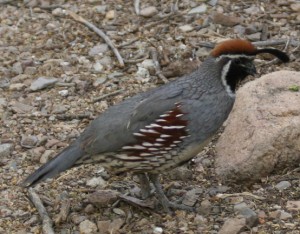General: Gambel’s Quail (Callipepla gambelii) are plump, volleyball shaped birds whose preference for remaining on the ground stems from their inability to fly fast or for extended periods of time. These social birds reside in desert habitats of the American southwest and can be found hiding amongst shrubbery and dense, varied desert vegetation. A popular game bird, Gambel’s Quail populations are healthy because of reproductive success. They are categorized as Least Concern on the IUCN Red List.
Description: Gambel’s Quail are plump, round birds with short, square tails and wings, stout necks, and petite heads and bills. They are best known for their comma-shaped plume that sits atop both males’ and females’ heads, although males’ plumes tend to be fuller. They reach a mature length of just under 10” and weight of 5.5 oz. to 7 oz, and have a wingspan of 13.5” to almost 14.5”1.
Gambel’s Quail have chestnut/gray bodies, olive wings, cream bellies and white or cream markings. Their richly patterned plumage provides camouflage from predators. Quail living in areas with greater rainfall tend to be darker and more vivid overall. Sexual dimorphism is also evident. Males have black faces, necks and patches on their breasts, fuller darker plumes, and are generally more striking than females, who tend to be grayer with thinner plumes and no black markings. Juveniles are mottled in gray and brown and have miniature head plumes.
Gambel’s Quail are known to hybridize with California Quails as well as Scaled Quails, although it is not common2.
Although Gambel’s Quail are diurnal, they rest during the heat of midday in shady areas. In cooler temperatures, quail tend to be active for longer periods of time. These social birds spend much of their time walking in groups, called coveys, of 12 or more birds3. They are fast runners and tend to remain on the ground. They only fly when necessary, in short, explosive bursts but prefer to lay motionless and camouflaged to escape from predators.
Gambel’s Quail live in coveys that generally contain a mature pair and up to 16 young4. These coveys have specific home ranges that they do not defend; rather covey’s home ranges tend to overlap.
Gambel’s Quail communicate with a number of calls. In addition to clucking and chattering, they emit a loud, high pitched “ka-KAA-ka,”5 and a plaintive qua-el6.
Gambel’s Quail live, on average, 7.4 years in the wild7.
Habitat: Gambel’s Quail may be found in hot deserts, thickets, mesquite springs, mountain foothills, river valleys, shrublands, grasslands, plains, and fields throughout the American Southwest. They prefer areas with brush and diverse vegetation and to be in close proximity to a water source, although they have minimal, if any, free water requirements8. Areas with dense desert shrubbery and trees offer shade and protection to Gambel’s Quail during the day and a place to roost at night. Predators within their native habitats include snakes, coyotes, bobcats, foxes, and birds of prey.
Gambel’s Quail do not migrate and their annual movements typically do not exceed 1.5 miles.
Location: Gambel’s Quail are found in desert thickets and shrublands9 in the southwestern U.S., especially in Arizona. Populations may also be found in parts of Mexico, Texas, Utah, Colorado, Nevada, and California. There are small, non-native populations living in Hawaii, introduced beginning in 192810.
Diet: Gambel’s Quail are group foragers and feed twice a day, moving slowly along the ground in the morning and afternoon. Approximately 90% of their diet consists of plant matter, which they scratch up from beneath vegetation. They also consume seeds and leaves year round. Gambel’s Quail will eat insects during the spring and early summer, while partaking in reproductive activities. They also eat fruit, berries, and cacti during certain seasons and in certain geographic areas11.
Reproduction: Gambel’s Quail reach sexual maturity by one year of age, breed once annually and are generally considered monogamous. However, females have been observed leaving their young with the male in order to find a new mate and have a new brood. Reproductive success is affected mainly by two factors: temperature and rainfall. During years of above average temperatures and greater than normal rainfall, these birds experience reproductive success and, therefore, population growth (due in part to increased plant growth and food supplies.) These ideal breeding conditions oppose the usual dry, arid habitat of the Gambel’s Quail.
To attract their mates, male Gambel’s Quail give small offerings of food to females. Studies have shown that males who exhibit faster rates of food offering, also called “tidbitting,” tend to have greater reproductive success.
Females tend to choose nesting sites that are hidden or in a protected place on the ground, although quail nests can be located up to nearly 30’ off the ground if conditions allow. These nests are shallow and broad, often measuring 5” to 7” wide and are lined with feathers, leaves, or vegetation.
Between 10 to 12 smooth white eggs are laid, camouflaged with brown splotches. During dry years, clutches tend to be smaller. Female Gambel’s Quail do the majority of incubation, lasting between 21 and 23 days on average, although males will assume incubation duties if the female leaves the nest or dies. Down-covered young are able to follow their mothers, run and feed soon after birth, and both parents participate in caring for the young. In the event that one parent leaves the brood or dies, a single parent is capable of caring for the young quail12.
Notes of Interest: The Gambel’s Quail is a popular game bird. Hunters enjoy a long season with few restrictions and are able to bag up to 15 birds in a single day13.
Footnotes
1. http://www.allaboutbirds.org/guide/Gambels_Quail/id
2. http://animaldiversity.ummz.umich.edu/accounts/Callipepla_gambelii/
3. http://www.allaboutbirds.org/guide/Gambels_Quail/id
4. http://animaldiversity.ummz.umich.edu/accounts/Callipepla_gambelii/
5. http://www.allaboutbirds.org/guide/Gambels_Quail/id
6. http://animals.nationalgeographic.com/animals/birding/gambels-quail/
7. http://animaldiversity.ummz.umich.edu/accounts/Callipepla_gambelii/
8. http://animaldiversity.ummz.umich.edu/accounts/Callipepla_gambelii/
9. http://animals.nationalgeographic.com/animals/birding/gambels-quail/
10. http://animaldiversity.ummz.umich.edu/accounts/Callipepla_gambelii
11. http://animaldiversity.ummz.umich.edu/accounts/Callipepla_gambelii/
12. http://animaldiversity.ummz.umich.edu/accounts/Callipepla_gambelii/
13. http://animaldiversity.ummz.umich.edu/accounts/Callipepla_gambelii/
http://www.allaboutbirds.org/guide/Gambels_Quail/id
http://animaldiversity.ummz.umich.edu/accounts/Callipepla_gambelii/
http://animals.nationalgeographic.com/animals/birding/gambels-quail/
